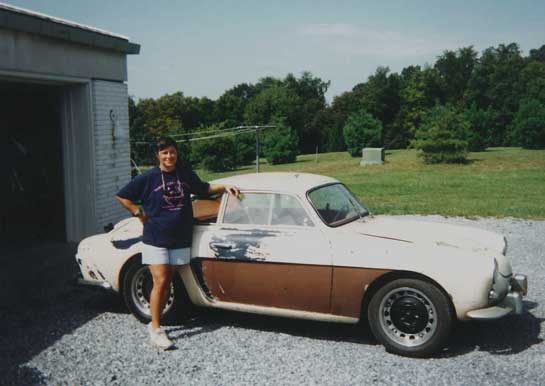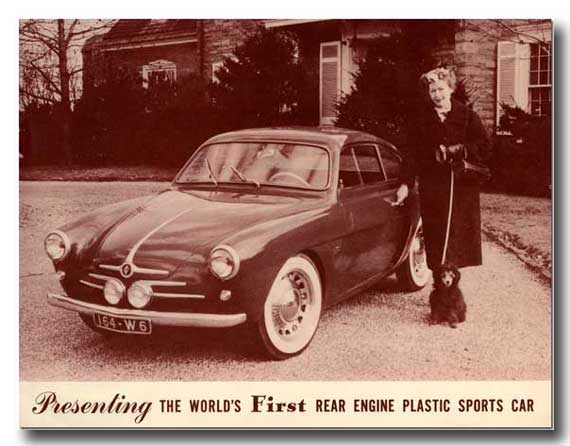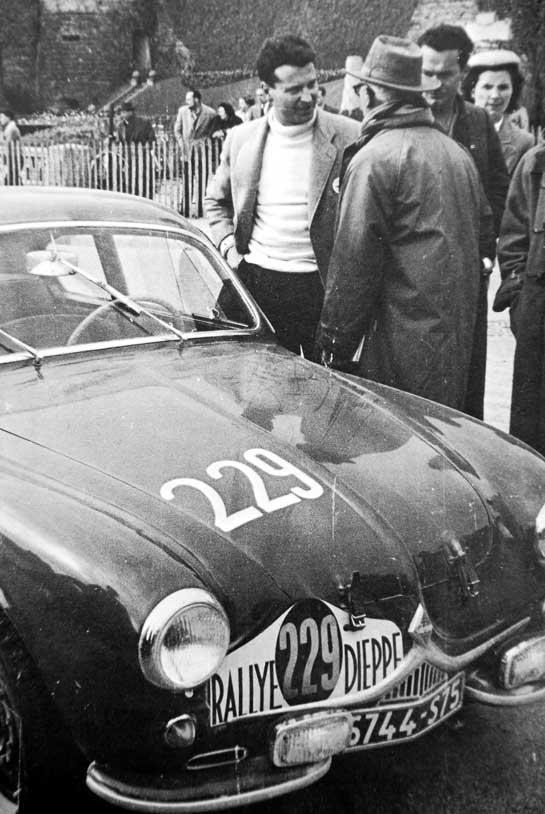A rare barn find in the States leads Roy Smith to Alpine’s Jean Rédélé, French Champion Louis Rosier, the post-war US sports car craze, Porsche champion Bob Hobert, and back to France for Retromobile, all in search of a car that never existed. An incredible story in three parts.
By Roy Smith
Barn Find
“The car belonged to my father, Raymond Buckwalter; he drove it for a while, and then parked it. I soon found out why he parked it when I wanted to drive the car for a few months in 1958. Every time I turned the motor off and left it for a while, the car wouldn’t start again without a push. This kind of thing you remember, believe me! I always parked in the same parking lot and the attendant always saved a spot for me. Five days a week they would push me to get it started. I guess my father figured I couldn’t go shopping unless I could find some kind person to push it a few feet, but as I was a young lady at the time, I always found some kind gentleman to give me a push. It was the battery; something was draining it. Rather than fix it my father liked to challenge me and he would often laugh at how I managed these small challenges. Now the memory of it makes me laugh – I can just imagine me in a parking lot at my age trying to get someone to give my car a push! When I went to get it painted in the late 90s we found traces of blue, so I assumed that was the original color.” —Mary Ann Wood
Those words of introduction and the photograph above tell of a time in the 1950s and a very interesting car. The car is the original Rédélé 1953 “Renault Special number 2.” Slightly modified, tidied up, prepared and shipped to the USA for the New York Motor Show of 1954 it was used to raise interest and promote sales of a car planned to be built in the USA called the “Marquis”. But the story it is not that simple, as time has a habit of spinning interesting diversions.

The aluminum-bodied ex-New York Motor show car in the late 1990s when still owned by the Wood family. Under the white was the original blue paint.
Marvin was sure the “barn find” was connected to the Marquis. He hoped one day he might find a glass-fiber-bodied Marquis. He sent me a picture of a strange car with a Renault engine. But was it the long sought after Marquis? If not, just exactly what was it?
Enter Jean Rédélé
Jean Rédélé, the son of a garage owner in Dieppe, had taken up rallying and had been using the ubiquitous Renault 4CV 1063cc. By the end of 1952, he had already proved a formidable competitor in many events, including the Coupe des Alpes, the Monte Carlo Rally and the Mille Miglia, in which he won his class. He entered the 1952 Le Mans 24 Hours and finished in 17th place overall; with co-driver Guy Lapchin, they covered some 2388km. In 1953 Rédélé, along with his rally co-driver Louis Pons, again went rallying and also entered the Mille Miglia, finishing 8th in the Sports 750cc class. 13-14 June saw them in Le Mans for the 24 Hours of that year, but Rédélé and Pons failed to finish.
By now, though, Jean Rédélé definitely had other things on his mind: he was dreaming of becoming a car manufacturer. The future father of the marque Alpine had in his hands a recently-ordered lightweight car built on the floor pan chassis of a Renault 4CV. Evolved in 1952 after Rédélé had met Giovanni Michelotti, a young Italian designer trained by Giovanni Farina who had worked with Serafino Allemano before setting up his own studio in 1949. Jean Rédélé liked the quiet Italian and asked him to design a sports coupé on the base of the 4CV. Happy with the result, he asked him to make the car, entrusting the bodywork specialist Allemano to do the work. Rédélé collected the finished vehicle in Italy and drove it back to France in December 1952 at the end of his honeymoon following his marriage to Michelle Escoffier, daughter of Paris Renault dealer Charles Escoffier. The aluminum-bodied creation on the 4CV chassis weighed just 550 kilos. It wasn’t perfect, but it had his signature: it was “his” first car. Under the rear engine cover, the original engine was greatly improved by the modification of mechanical parts acquired from Satecmo and a “Rédélé-Pons-Claude” 5-speed gearbox.
Rédélé Renault Special Number 1
He entered it as a “Renault Special” in the Dieppe Rally. Carrying No. 229, he won the event in front of a 3.4 litre Jaguar XK120 and in doing so won all the categories, as it was the car with the smallest power unit! For his second event it underwent some modifications. Visually, the front chrome work was changed, much of it being removed. He cut out a vent below the rear wing to improve cooling to the engine and on 15 July 1953 at Rouen Essarts, in front of 20,000 spectators, he again won the 750cc class. He repeated the feat once more at the Coupe de Lisbon on the Monsanto circuit in Portugal on 26 July, winning his class and finishing fourth overall behind three Porsche 1500s and in front of several more powerful cars. He ordered a second body shell and built a car incorporating some modifications and improvements. It was shortly after when an American, Zark W. Reed entered his life.
Credits
I owe several people thanks for the information and photographs that appear here, so I will do it now. From the USA, Dan Wood and his mother Mary Ann; Marvin McFalls, President, Renault Owners’ Club of North America for his diligent research. A thank you, too, to literary friends in France, Jean-Luc Fournier and Christian Descombes. I also recommend to the reader various bibliographic sources: Chappe et Gessalin by Michel Delannoy; Jean Rédélé – Monsieur Alpine by Jean-Luc Fournier; Alpine by Dominique Pascal; and Alpine Label Bleu by Christian Descombes and Thierry Cullafroz. A special thanks to Carl Goodwin and Larry Holbert for providing never seen photos from the collection of Bob Holbert.
Roy Smith is the author of several books about the Alpine company. Soon to be published is work on the life of Gordini and later in 2013 a work entitled “Alpine Renault- the fabulous berlinettes”. Portions of this three part story appeared in the French “berlinette” magazine.
Next: Part 2 Dreams of Glass



I was an engineer at Renault in the USA, which had a retail location and a huge warehouse in Queens, New York. The 1063 nomenclature refers to the factory racing model of the 4CV sedan, which had an engine of 750cc. The R 1063 had a special crankshaft, cylinder head, manifold, carburetor, camshaft, transaxle, and numerous other enhancements. The Renault factory sedans were very successful in their class. The normal 4CV engine suffered from many limitations. Despite its high (in the block) camshaft, because of its weak valve springs, valve float was inevitable at higher revs. The crankshaft was a weak casting, and it only had a three speed transaxle. The fiber camshaft drive gear was also a weakness.
Don Falk
Fascinating! I well remember this car’s appearance at a New York show and added its brochure to my collection at the time.
I look forward to reading more about the story behind it. Great stuff!
Hi there,
Boy am thrilled to have subscribed to your newsletter!
2 weeks later I am rewarded with this fantastic resurfacing of what is essentially the very first Alpine if I’m not mistaken?
I’m French and so often regret that so many of our interesting cars were the subject of a huge diaspora. I find comfort though in knowing that most went into diligent, affluent and capable hands. I was recently in Dieppe (August 10th) to celebrate the 100th anniversary of the French Grand Prix which took place in Dieppe in 1907-1908-1911 & 1912. The lineup of cars there was absolutely epic with a Sizaire and Naudin racecar ‘Le Monstre’; sundry Sunbeams, Lorraine-Diettrich and the Peugeot which won the 1911/12 editions. Needless to say that I would be honored to assist (with my friend who organized this commemoration) in getting the Alpine back to Dieppe, if only for a day and to celebrate 60 years of its entry in the Dieppe rally! Just wondering if the car happens to be for sale or what’s in the cards for it in the foreseeable future?
Regards,
Tom Bromehead